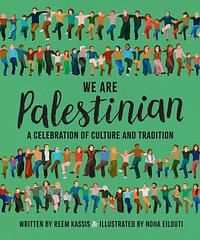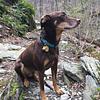Take a photo of a barcode or cover
I found this to be a great introduction to the Palestinian culture and history - perfect for young readers. The only part I found odd was that when it introduced the History & Religion section, it lists Islam, Christianity, and Judaism but then only goes into detail for Islam and Christianity and then just ends with Christianity with no real ending for the book. Idk I found it to be weird how abruptly it ends, but overall it's a great read - read it in a single sitting at work.
informative
medium-paced
informative
medium-paced
4.5 Stars
CAWPILE = 7.89
While I felt that this gave us a little misinformation as it stated that it was Palestinian people versus Jewish people multiple times when you can't really compare a country's people to people of a worldwide religion and in doing so it erases part of the identity of the 13% of Palestinians who are also Jewish. That and the fact that some of the illustrations could have benefited from annotations so the reader knew what they were representing as there was more than one illustration on some of the pages. A pronunciation guide would have been a nice thing to include too as I don't like to mispronounce things and as this is marketed at middle-grade children it could have aided them in learning the correct pronunciation from the beginning.
Those things aside the book does a really good job at giving you a glimpse into what it means to be Palestinian and things that are of cultural significance to the people and the country. While it does cover the hardships that the country has endured it mainly focused on things like the country's food, cinema, music, literature, crafts and main religions. It's given me lots of things to look up and it's good at a reminder of the humanity behind the too-often skewed reporting by the western world's media.
Emetophobia notes: I found this to be free of triggers for emetophobic people.
CAWPILE = 7.89
While I felt that this gave us a little misinformation as it stated that it was Palestinian people versus Jewish people multiple times when you can't really compare a country's people to people of a worldwide religion and in doing so it erases part of the identity of the 13% of Palestinians who are also Jewish. That and the fact that some of the illustrations could have benefited from annotations so the reader knew what they were representing as there was more than one illustration on some of the pages. A pronunciation guide would have been a nice thing to include too as I don't like to mispronounce things and as this is marketed at middle-grade children it could have aided them in learning the correct pronunciation from the beginning.
Those things aside the book does a really good job at giving you a glimpse into what it means to be Palestinian and things that are of cultural significance to the people and the country. While it does cover the hardships that the country has endured it mainly focused on things like the country's food, cinema, music, literature, crafts and main religions. It's given me lots of things to look up and it's good at a reminder of the humanity behind the too-often skewed reporting by the western world's media.
Emetophobia notes: I found this to be free of triggers for emetophobic people.
Moderate: Death, War
Minor: Murder, Injury/Injury detail
hopeful
informative
sad
fast-paced
Moderate: Genocide, Violence, War, Injury/Injury detail
hopeful
informative
reflective
fast-paced
informative
This is a really great book to introduce kids (or anyone) to Palestinian culture. It was very cool to learn about food and historical icons, especially. I want to look up some of these writers and see if I can find translations. Everything sounds lovely, and it's so painful to consider the current situation and what Palestine will look like in the future.
I'm a bit out of touch with reading to/with kids, but it wasn't clear to me what the target age range was for this content. The tough history felt well-written for most ages, but some parts and language seemed more advanced than I expected.
I did also find it curious that there is a section on each of Islam and Christianity, but none on Judaism, even though it talks about how all three religions have identity in the region.
I'm a bit out of touch with reading to/with kids, but it wasn't clear to me what the target age range was for this content. The tough history felt well-written for most ages, but some parts and language seemed more advanced than I expected.
I did also find it curious that there is a section on each of Islam and Christianity, but none on Judaism, even though it talks about how all three religions have identity in the region.
informative
reflective
medium-paced
informative
fast-paced
This is a really special book. It works great as a way to introduce kids to Palestinian culture, or to get a great overview of it as a teen or adult. As a way of showing you the kind of content to expect, I wanted to share my top three facts from each section. There are many more to be found within this wonderful book.
Geography:
- Nablus and Al-Khalil (Hebron) are the largest cities in the West Bank
- Nablus is known for its soap trade
- Haifa is home to the Baha’i Gardens, beautiful terraces
Cultural symbols:
- A keffiyeh is a type of hatta, which is a large square scarf worn on the head fastened with an egal
- Keffiyeh used to indicate you were from the country, and a tarboosh used to indicate you were from the city
- Most Arab countries use red, black, white and green as the colours on their flag
Creative minds:
- Mahmoud Darwish is considered the national poet of Palestine
- Samiha Khalil was the first woman to run for “president in the Arab world when she ran against Yasser Arafat in 1996”
- Mustafa Murrar is considered “the pillar of Palestinian children’s literature”
Agriculture:
- One of the most popular Palestinian snacks is roasted and salted watermelon seeds
- When making olive oil, the olive pits are dried and used as firewood
- Akras za’atar is “a flat bread layered with za’atar [the herb], green onions and plenty of olive oil”
Cuisine
- Mansaf (layers of bread and rice with lamb and yoghurt sauce) “is one of the most recognised celebratory meals for Palestinians.”
- Knafeh nabulsiyeh is a famous type of knafeh (stuffed dough “baked and soaked in sugar syrup”) that is stuffed with cheese, not nuts
- The Levantine countries are Syria, Lebanon, Palestine and Jordan
Performing arts:
- Dabke is the name of the dance performed in a line at celebratory occasions
- Zajal is a type of vocal Arabic music which is “performed as a debate” between the performers and is semi-improvised
- Mohammed Assaf is a singer who rose to fame after winning Arab Idol - he nearly didn’t make it on the show due to the delay at the Rafah Crossing. Auditions had closed but he managed to get into where they were being held, and when he still wasn’t given an audition, he just started singing there and then
History and religion:
- Jewish people believe their ancestor is Isaac son of Abraham, while Muslims believe their ancestor is Ishmael son of Abraham
- May 15th commemorates Al Nakba while June 5th commemorates Al Naksa
- Eid al Fitr follows Ramadan, while Eid al Adha “coincides with the Hajj pilgrimage”
Moderate: Colonisation, War
Minor: Death, Genocide, Gun violence, Sexism, Violence, Murder, Injury/Injury detail
Moderate: ethnic cleansing, forced displacement
Minor: the refugee experience, bombing








